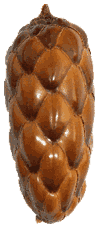 |
Palm |
 |
Palm |
Copernicia fallaensis in an endemic species of the central part of Cuba. Originally it was widespread at the provinces of Camagüey, Ciego de Ávila and Villa Clara, but today the best population is found in Ranchuelo, near Falla (the type locality). Outside of this area, only scattered individuals are found. Today, this palm is part of secondary savannas; originally it was a component of semideciduous forest on heavy clay and fertile soils in lowlands at 10–20 m.a.s.l.
Copernicia fallaensis has the largest dimensions of any species in the genus. Its trunk is up to 20 m tall and 0.8 m in diameter. The petiole is robust, up to 174 cm long and 7 cm wide at the apex. Its margins are coarsely spiny at the basal. The hastula is up to 8.5 cm long. The leaf blade is ovate, more than 200 cm long, with a costa up to 30 cm long. The blade has up to 120 segments. The inflorescences are many branched, up to 3.6 m long. The rachillae (flower-bearing branches) are 4 or 5 cm long. Flowers are solitary and very close together. The fruit is globose, up to 23 cm long and 19 mm in diameter.
Flowering occurs in May and June, coinciding with the onset of the first rainy season. No systematic pollination study was made in this species, but informal observations indicate that insects are involved. The fruits develop in four months, an they are mature in late September and early October, coinciding with a second rainy season. As with other species of the genus, fruits consumed by bats, which disperse the seeds. Most germination occurs after just one month.
.jpg) |
| Copernicia fallaensis in a secondary savannas in the wild (Ranchuelo, near Falla, in Ciego de Ávila province, Cuba). |
The large leaves of this palm are traditionally used by the farmers to made hats, brushes, baskets and many other articles. The leaves are removing for thatch too. When the palm was abundant, this traditional use was not a threat, but now the largest remaining population in the type locality is only of 84 adult trees, and overexploitation is the principal threat to this species.
The census in the largest population at Ranchuelo shows 84 adults and 187 juveniles, some isolated individuals are distributed nearby and in other sites where the species was reported in the past. Las Tunas Botanic Garden is working in education in the community and has coordination with the local authorities for conservation of this palm. With participation of local peoples seeds were collected, and an ex situ collection of 50 specimens was established.
A more extensive field survey is necessary in Florida, Camagüey and Esperanza, Villa Clara, two localities where the species was reported, to verified the remaining individuals and complete the census. Continued monitoring of the wild population, education of the local communities in sustainable use and reinforcement of the remaining populations are also needed.
Raúl Verdecia Pérez, Las Tunas Botanic Garden, Cuba.
León, Hermano. 1936.
Contribución al estudio de las palmas de Cuba: Género Copernicia II.
Mem. Soc. Cub. Hist. Nat. “Felipe Poey” 10: 203–226.
Dahlgren B. E. and S. F. Glassman. 1963.
A revision of the genus Copernicia. 2. West Indian species.
Gentes Herbarum 9: 42–232.